《Password Guessing Based on LSTM Recurrent Neural Networks》论文阅读笔记
摘要
- 人们倾向于选择有意义的单词或数字作为密码,许多密码很容易猜测
- 介绍了一种基于 LSTM 的密码猜测方法
- 在用 Rockyou 数据集的 3000 万个密码训练 LSTM 神经网络之后,生成 33.5 亿个密码可以覆盖剩余 Rockyou 数据集的 81.52%。与 PCFG 方法和马尔可夫方法相比,该方法具有更高的覆盖率
介绍
- 密码猜测旨在生成密码字典或数据集,以最小的大小覆盖尽可能多的用户密码
- 生成的密码可以检测用户密码的安全风险
- 生成的密码可以提升字典攻击的性能
- 近年的密码生成研究:
- 使用更好的模板【1,5,7,13,14】
- 使用字符之间的相互关系——马尔可夫模型【2,8,10】
- 递归神经网络具有揭示密码中所有字符之间相互关系的能力,而基于马尔可夫的模型仅考虑几个相邻字符之间关系
- 本文用泄露的密码训练网络,用搜索算法生成密码
- 实现了基于 LSTM 神经网络的密码猜测
- 对不同层数/神经元进行了比较
相关工作
- PCFG:
- Weir【1】提出 PCFG,从训练密码生成模板并用字典填充模板用于密码猜测
- Chou【7】开发了 TDT 模型来生成更精确的模板和字典
- Li 【5】改进了 PCFG,增加了中文拼音和规则
- Veras【14】用语义和句法标签建立 PCFG
- Houshmand【13】等人用键盘模式
keyboard patterns和多字模式multiword patterns优化了猜测效率【13】
- Markov
- Narayanan【10】在字典攻击中首次引入马尔可夫模型
- Castelluccia【2】将马尔可夫模型用于密码强度衡量
- Dürmuth【8】实现基于马尔可夫模型的的密码破解工具 OMEN,通过生成 100 亿个密码,猜中了 260 万个 Rockyou 密码的80%以上
- JTR【11】 与 Hashcat【3】
- 被用于有针对性的在线密码猜测【12】
- 【4、6】侧重于这两个模型的组合与评估
- 【4】显示,基于马尔可夫的模型比基于模板的模型显示出更好的结果
- Melicher【15】提出神经网络用于密码强度测量,使用 PGS 和 PGS+ 数据集训练数据,并用 MTurk 和 000Webhost 数据集测试
LSTM 循环神经网络
递归神经网络能够从序列中学习
递归神经网络中的神经元用长短期记忆(LSTM)神经元代替【9】,以避免梯度消失问题
LSTM 层的外部输入是一个数据向量矩阵,矩阵的行长度代表序列的长度,等于时间步长的数量。矩阵的列长表示批次中的序列数(批次大小);在每个时间步长,LSTM 层的外部输入是矩阵的列向量;一层的输出向量在下一个时间步会反馈给同一层的神经元
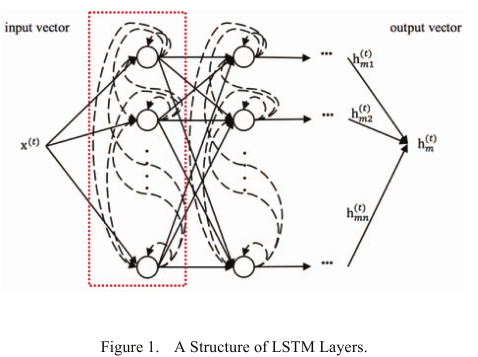
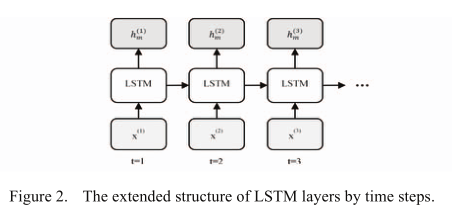
softmax 回归
Softmax 回归为多分类问题设计【16】
标签(类别)组成子集 C,标签个数为|C|
分类概率可以估计($y$ 代表标签,$\theta$ 代表回归的参数):
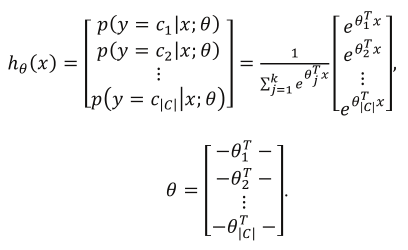
实现
密码猜测模型
- 本文神经网络包括一个输入层,几个 LSTM 层,一个 softmax 层和一个输出层
- 基本的假设:
- 密码 $p_1p_2…p_{len}$ 是一个序列 $x(1)=p_1,x(x)=p_2,…,x(len)=p_{len}$
- $x(t)$ 与前面的所有字符相关
- 基本的思路:
- $x(t)$ 的分布可以通过向网络输入 $x(1), x(2),…,x(t-1)$ 获得
- 泄露密码集训练网络
- 训练后给定前缀,下一个字符可以根据概率分布,由选择算法来决定
- 密码中的每个字符(除了第一个字符)可以根据顺序预测
密码预处理
- 泄露的密码分为3个部分:训练集、验证集(防止过拟合)和测试集
- 预处理:
- 数据清洗
- 确定密码的字符字典(添加特殊终止字符),以及密码长度范围
- 删除包含不良字符的密码
- 删除超过限制长度的密码
- 打乱密码
- 数据格式转换
- 密码字符替换
- 序列变换:将 $L(p_1)L(p_2)…L(p_{len})$ 转换为 $x^{(1)}=L(p_1),x^{(2)}=L(p_2),…,x^{(len)}=L(p_{len}),x^{(len+1)}=L(END)$
- 数据清洗
训练
- 给定训练数据 $x^{(1)}=L(p_1),x^{(2)}=L(p_2),…,x^{(len)}=L(p_{len}),x^{(len+1)}=L(END)$,监督的标签为 $y^{(1)}=x^{(2)},y^{(2)}=x^{(3)},…, y^{(len)}=x^{(len+1)}=L(END)$
- 这里介绍了训练的原理(略)
密码生成
由于能够预测字符的概率分布,每个密码前缀出现的可能性可以通过概率乘法公式来估计
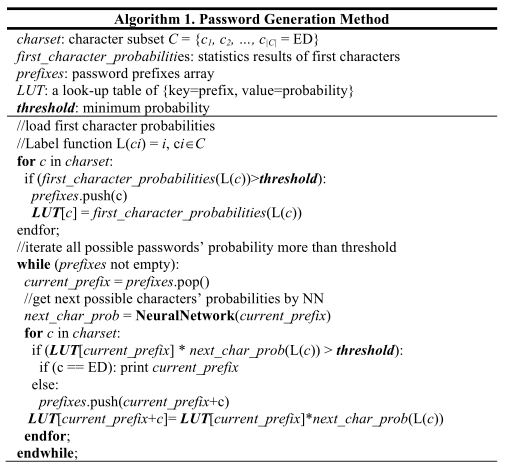
测试指标
覆盖率

实验结果
RNN 的重要参数
Hidden Layers Number (HLN)
实现了三个具有不同数量 LSTM 隐藏层(1、2、3层)的网络
实验在小规模生成数据集上进行,密码生成阈值为 $10^{-6}、10^{-7}、10^{-8}、10^{-9}$
下图为结果。x 轴代表生成密码数目的对数;HLN 的增加给结果带来轻微的、不明显的增加(在相同的阈值下仅约1%)
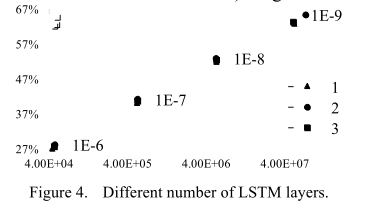
Neurons Number per Layer (NNPL)
实现了五个两层的 LSTM 网络,每层神经元数目分别为32,64,128,256,512
实验在小规模生成数据集中进行,阈值同上
下图为结果
随着 NNPL 的增加,覆盖率增加
覆盖率的增加逐渐减少
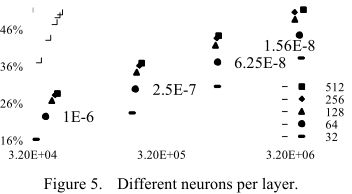
随着 HLN 和 NNPL 的增加,覆盖率在相同的阈值下增加,但训练和生成速度降低
后面的实验,选择了具有 2 个隐藏 LSTM 层、每个 LSTM 层有 256 个神经元的 RNN

与过往研究的对比
采样一些大规模数据集,与过去的研究对比
LSTM 模型包含 2 个隐藏的 LSTM 层,每层有 256 个神经元,由 3000 万个 Rockyou(RY)密码训练,包括 2700 万的训练集和 300 万的验证集
测试集:Rockyou 260万密码;Myspace 密码;Facebook 密码
与 OMEN-4Gram、概率上下文无关语法(PCFG)、JtR 马尔可夫模式和 JtR 增量模式
JtR incremental mode进行比较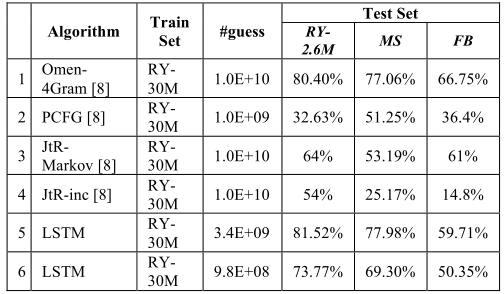
结论
- LSTM 递归神经网络可以应用于密码猜测
- 神经网络优于基于模板和基于马尔可夫的模型
- 了获得更好的结果,可以进一步调整神经网络的结构
- 未来的工作可能侧重于不同数据集之间的差异,研究常见或特定的神经网络
参考文献
[1] M. Weir, S. Aggarwal, B. d. Medeiros and B. Glodek, “Password Cracking Using Probabilistic Context-Free Grammars,” in 30th IEEE Symposium on Security and Privacy, 2009, pp. 391-405.
[2] C. Castelluccia, M. Dürmuth and D. Perito, “Adaptive Password Strength Meters from Markov Models,” in NDSS, 2012.
[3] J. Steube, “hashcat - advanced password recovery,” [Online]. Available: www.hashcat.net.
[4] J. Ma, W. Yang, M. Luo and N. Li, “A study of probabilistic password models,” in 2014 IEEE Symposium on Security and Privacy, 2014, pp. 689-704.
[5] Z. Li, W. Han and W. Xu, “A large-scale empirical analysis of chinese web passwords,” in 23rd USENIX Security Symposium, 2014, pp. 559-574.
[6] B. Ur, S. M. Segreti, L. Bauer, N. Christin, L. F. Cranor, S. Komanduri and R. Shay, “Measuring real-world accuracies and biases in modeling password guessability,” in 24th USENIX Security Symposium, 2015, pp. 463-481.
[7] H. C. Chou, H. C. Lee, H. J. Yu, F. P. Lai, K. H. Huang and C. W. Hsueh, “Password cracking based on learned patterns from disclosed passwords,” International Journal of Innovative Computing, Information and Control, vol. 9, Feb. 2013, pp. 821-839.
[8] M. Dürmuth, F. Angelstorf, C. Castelluccia, D. Perito and A. Chaabane, “OMEN: Faster password guessing using an ordered markov enumerator,” in International Symposium on Engineering Secure Software and Systems, 2015, pp. 119-132.
[9] Z. C. Lipton, J. Berkowitz and C. Elkan, “A critical review of recurrent neural networks for sequence learning,”. Available: arxiv.org/pdf/1506.00019.pdf.
[10] A. Narayanan and V. Shmatikov, “Fast dictionary attacks on passwords using time-space tradeoff,” in Proceedings of the 12th ACM conference on Computer and communications security, 2005, pp. 364-372
[11] S. Designer, “John the Ripper password cracker,” [Online]. Available: www.openwall.com/john.
[12] D. Wang, Z. Zhang, P. Wang, J. Yan and X. Huang, “Targeted online password guessing: An underestimated threat,” in Proceedings of the 2016 ACM SIGSAC Conference on Computer and Communications Security, 2016, pp. 1242-1254.
[13] S. Houshmand, S. Aggarwal and R. Flood, “Next gen PCFG password cracking,” IEEE Transactions on Information Forensics and Security, vol 10, Aug. 2015, pp. 1776-1791.
[14] R. Veras, C. Collins and J. Thorpe, “On Semantic Patterns of Passwords and their Security Impact,” in NDSS, 2014.
[15] W. Melicher, B. Ur, S. M. Segreti, S. Komanduri, L. Bauer, N. Christin, and L. F. Cranor, “Fast, lean and accurate: Modeling password guessability using neural network,” in Proceedings of USENIX Security, 2016.
[16] Stanford UFLDL. “Softmax Regression” [Online]. Available: http://ufldl.stanford.edu/wiki/index.php/Softmax_Regression.

